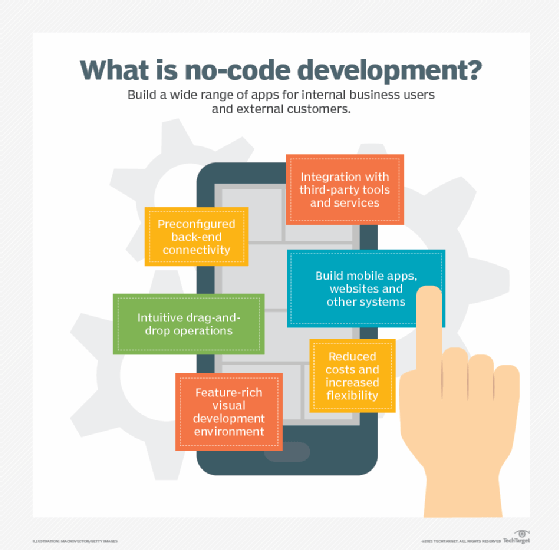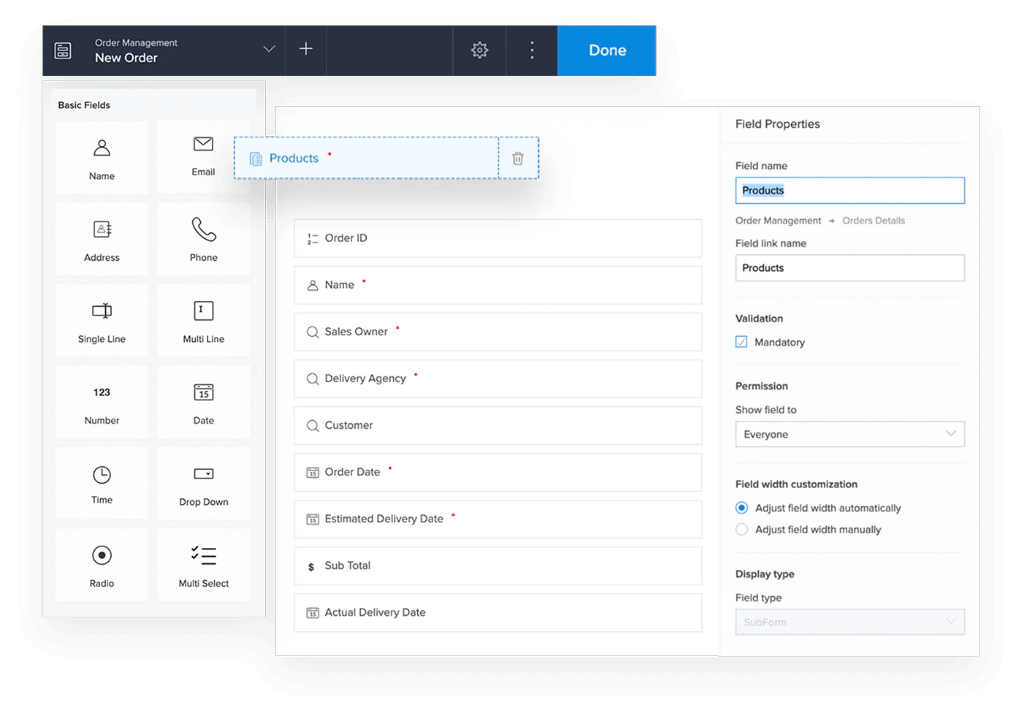Great Ideas For Picking Low-Code Platform Examples
Great Ideas For Picking Low-Code Platform Examples
Blog Article
The Ease Of Use Of Low-Code Apps Is Among The Major Advantages.
Due to a number of important factors, Low-Code Application Development is available to non developers. They are also known as "citizen designers."
Drag-anddrop Builders: Lowcode platforms provide drag-and-drop interfaces, which allow nondevelopers to visually create applications without the need for codes. The development process is now easier for those who have no technical background.
WYSIWYG: WYSIWYG editors are "What you see is what you Get" editors that allow users to design workflows and interfaces similar to the finished product. It makes it much simpler to use and understand.
Simplified Logic Design and Workflow Design
Visual Workflow Modeling: Users can develop business processes and apply logic by using visual flowcharts or models, which are easier to understand than conventional coding techniques.
Low-code platforms often have pre-built logic elements (e.g. conditionsal statements, loops) which can be easily modified, eliminating the need for complex coding.
Reusable Components and Templates
Libraries of pre-built templates: A lot of low-code platforms offer an application library that can be used of the most commonly used types of applications, providing non-developers to have a foundation to build on and later customize.
Reusable Widgets and Modules Users can make use of reused widgets and modules, streamlining the creation process and reducing the need for in-depth technical knowledge.
Guided Development and Tutorials
Step-by-Step Guides: Platforms often offer a set of development guides along with tutorials and guidelines to assist novice developers in creating applications.
Interactive Tutorials. Interactive, hands on tutorials enable users to gain knowledge by doing.
Integration with an existing tool:
Seamless Integration - Low-code platforms can easily be integrated with existing systems and business tools (e.g. ERP CRM) which gives even non-developers the ability to develop apps that work to their workflows.
APIs Connectors, APIs: These tools make integration easier by allowing non-developers (or even end users) to link their applications to external services.
Collaboration Features:
Team Collaboration - Features such as real-time team collaboration, and shared workspaces help non-developers collaborate with analysts, professionals, analysts, and the other stakeholders.
Role-based access control: Access levels are able to be set for those who are not developers in order to ensure that they are able contribute to the development process, but without compromising the security.
Automated Testing and Debugging
Built-in Testing Tools: Low-code platforms typically come with built-in testing and debugging tools to automate these procedures, making it simpler for non-developers and users to ensure that their applications work correctly.
Error Highlighting Whenever errors are detected, the platform highlights these and suggests possible fixes. It guides non-developers in finding solutions.
The primary benefit of low code application development for accessibility to non-developers comes in its ability to democratize the process of developing. Platforms with low-code enable business users by offering them an intuitive, visually and logical tools. They can then actively contribute to the development and maintaining the applications. Take a look at the best Low-code Platform for application development blog for blog advice including low code development platforms, develop mobile application, paas service, cross platform mobile dev, rad development, lowcode no code, mobile development platforms, driver jdbc, cross platform mobile development, cloud software applications and more.
Advantages Of Low-Code Application Development In Terms Of Scalability And Flexibility
Low-code development can bring many benefits in terms of scalability and flexibility that are essential for creating applications that are able to grow and adapt to changing business needs. These are the major benefits: Rapid Scaling:
Cloud-based deployment : Many low-code platforms are built. This lets applications scale seamlessly along with the cloud infrastructure. This enables businesses to manage more workloads without having to worry about managing servers.
Auto-Scaling Functions: Auto-scaling functions can be utilized to automatically adjust resources in response to the demand. They guarantee that performance is constant at peak times.
Flexible Architecture:
Modular design Low-code platforms are a great way to promote modular applications. This allows components to be developed independently and tested, scaled or even resized. Modularity improves flexibility and it is easier to update specific parts of an app without having to alter the whole system.
Microservices Integration Microservices Integration: Support for microservices architecture allows applications to be built as a collection of loosely coupled services, enhancing both flexibility and scalability.
Customizable Solutions
Extensibility : Low-code platforms allow developers to enhance functionality beyond the standard features. This allows for unique business needs to be fulfilled without restrictions.
Third-Party Integrations: The incorporation of APIs, third-party services or other services allows companies to expand the capabilities of their applications by incorporating additional functions.
Agile Development & Deployment
Continuous Deployment and Delivery: Low-code platforms are able to support agile processes, allowing continuous deployment and integration (CI/CD). This enables rapid deployment of updates and new features, assuring that applications can evolve quickly in response to user feedback and market trends.
Iterative Development: The nature of development using low-code means applications are able to be incrementally improved and scaled up, reducing the risk associated with large-scale changes and allowing for more controlled growth.
Resource Optimization
Efficiency in Resource Management: Low-code systems allow you to maximize the use of resources by offering tools for monitoring and managing application performance. This ensures that resources are used efficiently, and can be increased or decreased in accordance with the needs of the moment.
Load Balance: This feature lets the application handle massive traffic by distributing workloads over multiple servers. It also ensures performance is consistent.
Global Reach
Multi-Region Implementation: Low code platforms can be deployed across many geographical regions. This allows businesses to provide users with low latency access worldwide. This is particularly important for apps that are popular with a worldwide user base.
Localization Support: Built-in localization support allows applications to easily be modified to accommodate different languages and regional needs. This increases their flexibility in a variety of markets.
Updates and maintenance
Low-code applications are visually and modularly designed, which simplifies maintenance. Updates or bug fixes can be done quickly and without a lot of downtime.
Version Control Systems for Controlling Versions can assist you in managing updates, rollbacks and other changes. They will make sure that they are released safely and previous version can be restored when needed.
Cost Efficiency:
Reduced development costs: Low-code systems permit a reduction in the development cost by eliminating the requirement to code extensively. This lets applications be expanded without a significant increasing the development cost or effort.
Pay-As.-You-Go A lot of lowcode platforms offer flexible price models, including pay-as.-you-go. These align costs to actual usage and growth, allowing financial flexibility.
Overall the scalability, flexibility and scalability advantages of low-code applications let businesses build robust, adaptable and scalable applications quickly. These platforms permit quick adaption to evolving requirements as well as efficient utilization of resources and continuous advancement. This ensures that applications can grow with the business. Follow the recommended these details for Enterprise application development with Low-code Platform for more recommendations including ms azure sql, low code development platforms, push alerts, microsoft azure sql, cross platform mobile dev, no code platforms, driver jdbc, multiplatform mobile app development, push notifications, jdbc server and more.
Benefits Of Low-Code Application Development In Terms Of Customization And Limitations
Low-code development is an approach that is balanced and offers significant advantages in terms of dealing with limitations and permitting customisation. These are the main benefits: Handling Limitations:
The Challenge of Overcoming Complexity
Low-code platforms simplify development by providing templates that are pre-built and other components. This allows faster deployment and development of complex applications.
Guided Workflows: Many platforms offer guided workflows and wizards to assist developers in navigating through complicated processes, reducing the risk of mistakes and ensuring consistency.
Scalability Solutions
Built-in Scalability: Low-code platforms include many features that allow for the design of scalable architecture, which allows applications to cope with increased loads without major redevelopment.
Performance Monitoring Performance Monitoring: Tools for monitoring performance and optimization ensure applications are as efficient as they can be, no matter their size.
Security and Compliance
Security features integrated into low-code platforms include security measures such as encryption as well as role-based access control and automated compliance checks that address security issues.
Platforms regularly update their security protocols, and make sure that they comply with regulations. This keeps platforms safe from new threats.
Customization capabilities:
Extensibility:
Custom Code Integration: Low-code platforms usually allow the integration of custom codes (e.g., JavaScript, Python) which allows developers to enhance the functionality beyond the basic features.
Custom Modules and Plugins: Developers can have the option of designing custom modules or plugins to tailor specific functions to meet the specific requirements of a particular business.
APIs Integration
API Support: Full API support is available to facilitate seamless integration and connection with other systems.
Third-Party Services : Low-code platform often provides pre-built connections for popular services from third parties which makes integration and customization easy.
Flexible Design for UI/UX
Customizable User Interfaces: Developers are able to alter and design user interfaces that are in line with the specifications for branding and usability, creating a tailored user's experience.
Responsive design: The capacity to customize applications for different devices and screens is built-in.
Customizing Business Logic is easy:
Visual Workflow Builders: Visual tools to create and modify workflows, business logic and processes enable developers to create complicated and customized processes without lengthy programming.
Conditional Logic & Scripting: Platforms allow the use of conditional logic and custom scripting for handling specific business rules.
Data Management:
Custom Data Models Developers are able to develop custom data models tailored to specific business needs. This means that the handling of data is customized for every application.
Advanced Data Processing: The integration with advanced data processing tools and capabilities permits customization of the way that data is analysed and utilized within the application.
Balance Customization and Limitations:
Frameworks and Standards:
Low-code Platforms Encourage Industry Best practices and standards: Low code platforms encourage the adherence of industry-standard best practices and standards. This allows for the maintenance of top-quality, secure, and adaptable applications.
Governance Frameworks. The built-in governance frameworks ensure that any modifications are not detrimental to the security, integrity or security of the application.
Feedback and Iterative Design
Rapid Prototyping: The ability to quickly test and prototype changes allows developers to iterate based on user feedback improving the app to better satisfy the user's needs.
Continuous Improvement: Platforms with low-code support for continuous improvement, allowing customization and enhancement as business needs evolve.
Users Empowerment
Giving Citizen Developers the tools they need In allowing non-developers make customizations through simple interfaces, low-code platforms broaden the number of users who can improve and customize applications.
Training and Support: A lot of platforms offer comprehensive training and support to assist users with effective customizations without compromising the stability of the application or its performance.
In the end, low-code application development offers a framework that is sturdy and adaptable enough to meet constraints while also allowing ample customization. This allows businesses to create and maintain applications that are tailored and functional to meet their specific requirements, while maintaining high levels of safety, quality, and the ability to scale.